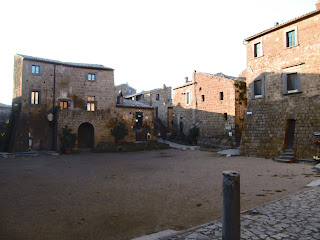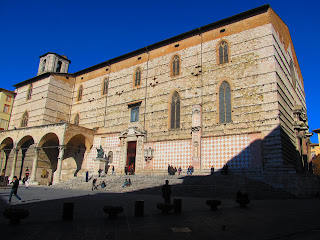Since arriving in Italy six weeks ago, we have been doing a lot of nothing at all. It has been WONDERFUL. We have had holidays before, from which we arrived home exhausted and needing a holiday.
Travel is hard! It all looks as though it will be OK at the start; you've booked and you just want to get on with it now. In the comfort of your own home, you take down the suitcases, pack and unpack and re-pack them several times before you're (still only relatively) happy with your choices, deciding that if you have forgotten anything, you will have to just buy another while you're away (if you
can buy another - there's always the lingering doubt - maybe the socks in Paris won't be as thickly warm as the socks you have in your drawer at home - *insert apprehensively concerned emoticon here*). Is the pent-up excitement starting to unravel, just a tiny bit?
You organise a ride to the airport to drop you there hours ahead of your scheduled departure time. You worry that there might be a delay on the freeway. What if there's an accident up ahead? You worry that there will be a delay at check-in. What if my case is too heavy? You remember that you have left your watch on the bedside table at home. You are irritated by the bazillions of other travellers at the airport. You look around you while sitting at the gate lounge and think, "How can all of these people fit onto an aeroplane without it going down?" (OK, that's probably just me). You wait for
ever until it's boarding time, realising that your seat number will mean that you are boarding almost last of all the people sitting around you. You consider trying to queue jump. You wonder if you should have brought a walking stick and pretended to be one of those people who need to be boarded ahead of everyone else - you wonder if that lady over there thought the same thing and is in fact faking it, with that plaster cast on her ankle. You finally board and then you wait some more, until the captain announces a further delay because the pax numbers don't match the check-in luggage number... and on it goes, like that.
Shall I continue? Shall I talk about stopovers and worrying about missing a connection? Shall I talk about less-than-brochure-quality hotels and lack of facilities and the difficulties of navigating public transport in a foreign language? Shall I talk about how it's all worth it, in the end? It is.
My conclusion is that short breaks away from home might not be, but when you take a longer vacation, all of the above are insignificant in the scheme of things, and it's a long vacation we are taking this time.
Staying for a month in one place means that it
is worth unpacking your suitcase completely, hanging things in a wardrobe and folding clothes into drawers. You can open the curtains in the morning and depending on the weather make or change plans for the day. You can afford to take an afternoon nap for 2 hours (every day...) if you feel like it, because "there's always tomorrow" to sightsee. Staying in an apartment instead of a hotel while you are away means that you can wash and iron your clothes when they need it, you can go into another room to read quietly while your partner watches TV in another language in another room, you can make sandwiches for lunch and salad for dinner if that's what you feel like eating, you still have the luxury of someone else coming in once a week to change the bedlinen and towels, clean the bathroom and kitchen and vacuum the floors, while in-between you can leave everything just as you please because no-one is coming through that door. I highly recommend a long break coupled with staying in an apartment, if you're planning your next trip while reading this blog.
Doing nothing while watching others doing things is a very pleasant way to relax in Italy, if you have the time for it. Below is a list of some of the people I have enjoyed watching over the last few weeks:
- the barber who runs the shop near our apartment - most of the time he seems to be sitting in one of his chairs with his feet up, reading La Nazione or La Repubblica, or chatting with buddies who've dropped by;
- the old guy who sits behind the newsagent's counter - he must be 87 and possibly hasn't shaved since Berlusconi's first time in office - he doesn't need to look up to say, "One euro." How does he know I don't speak Italian without even looking at me?
- the shop owners who diligently and aggressively scrub the doorsteps of their shops every morning with hot, soapy water and a broom, only pausing to greet passers-by, all of whom they know by name ("Ciao, Giovanni! Che freddo!" - "Hi, Giovanni! How cold it is!");
- the old men who gather in groups in all the best and sunniest spots around town - what do they talk about, so animatedly? How do they know where today's meeting spot will be? My personal opinion is that Italian men live longer simply because they function in these groups on a daily basis. They laugh and chat and observe and consider and relate in a closely networked support group of friends. It's good for them. I bet there are no old gents in psych counselling - they sort it all out with their amici;
- the guy who owns the porchetta caravan, from which he dispenses just-out-of-the-oven-and-sliced-in-front-of-you slabs of stuffed suckling pig - fresh bread wrapped around it, optional - the long queue in front of the caravan is testament to the popularity of this snack, even at 10:00 in the morning;
- my blue-eyed, filmstar-handsome vegetable guy at the market - it's probably getting a bit obvious to him that I am a great admirer of his zucchini, because he always winks at me when he hands me the change;
- my hairdresser (yes, I have a hairdresser here - it only costs 14 euros for her to wash and blow-dry my hair - why would I do it myself?) - Anna is quite short - I have to scrunch right down in the chair for her to be able to reach the top of my head - no such thing as a gas-operated chair-lifting device;
- the French chap who serves us at the local wi-fi connected cafe. "So, what are you doing here in Italy, Antoni?" reveals the obvious answer: "I fell in love with an Italian girl," he gestures, pointing to the barista;
- the lady who lives behind us who calls out, "Ciao! Buongiorno!" as she hangs out her washing in the mornings and sees us on the sun terrace; and
- the doting nonnas (grandmothers) who push their charges around in prams, wearing the broadest of smiles which we can interpret as, "Do you see how beautiful this child is?"
OK, that's enough. I leave you with this
pecorino tasting plate, which we enjoyed yesterday with a basket of fresh, crusty bread and two glasses of very good
vino rosso. The photo is not significant, save for me to underline again the point of this blog: sometimes the simplest things in life are the best.
D1




















































